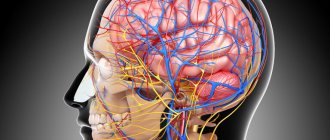Everyone is surrounded by people who react violently to everything that happens. But this does not mean at all that they are mentally abnormal. They are simply impulsive, hot-tempered, unrestrained, sensitive by nature - typical manifestations for sanguine or choleric people. However, excessive impressionability and quick excitability are not always determined only by the type of character. In some cases, they talk about damage to the nervous system and pathology, which in psychology is usually referred to as emotional lability.
What it is
Emotional lability is a serious disturbance in the functioning of the central nervous system, the main symptom of which is mood variability, its sharp fluctuations without objective explanations. The person reacts too painfully to what is happening. He can burst into tears of happiness just because someone gave him a compliment, and a moment later he can throw a real tantrum because someone walked past and didn’t say hello.
Experts explain emotional lability by physiology. To any external stimuli, responses are formed in the cerebral cortex. If the central nervous system is in order, a person can slow down and restrain some of them. But, if it is weakened, this provokes an overly violent response, even to an insignificant event. The opposite concept in psychology is rigidity, when a person is stingy in expressing emotions.
If they say about a person that he is emotionally labile, this means that he is subject to sudden mood swings and reacts too violently to everything that happens around him. Moreover, he is not able to control this flow of emotions. Communication with such people requires endurance, patience and understanding on the part of family.
Rationale for character trait research
Why it is necessary to study the types of accentuation of differences between individuals has two objectives. Firstly, this is a research goal - to identify as many groups as possible and develop specific advice for representatives of each of them. The more classes are identified, the more effective psychological recommendations for their representatives will be.
Secondly, it is necessary to know the types so that the person himself understands the characteristics and reasons for his behavior and can, in accordance with this, correct it.
Often in this regard, everyday psychology is completely insufficient. For example, there is a common belief that fat people are kind. Conversely, a thin person is sometimes perceived as anxious and wary. Of course, such a breakdown into categories may be partly correct. Even Hippocrates did not avoid such an error in classification, although already in the medical field: once upon a time, an ancient doctor directly linked the tendency to apoplexy with obesity.
Soviet psychologist A. E. Lichko, like the German psychiatrist K. Leongard, used the concept of “accentuation” in their research. When applied to a specific property, this term means that it is highlighted more clearly than others, as if emphasized. In other words, accentuation is the expression of a certain character trait. For a person with this or that quality, certain social situations will be very painful, while others will be easily tolerated. This article will discuss the types of accentuation according to Lichko and Leonhard.
The psychology of differences is not a strict discipline. Types of accentuation are always descriptive in nature and are practically never found in their pure form. Each person can find himself in two or more types.
It should also be noted that assigning oneself to a certain category should not be aimless. When playing psychological tests, you need to ask yourself the question: “Why am I doing this?” If a person understands that he belongs to one group or another, he needs to develop for himself an appropriate compensation and self-help strategy. To do this, you need to study the advice given by psychologists for representatives of different classes and apply them to life.
From the editor: Causes of numbness on the left side of the face, their diagnosis and treatment
Causes
Emotional lability can be caused by various factors.
Physiological:
- avitaminosis;
- HIV;
- thyroid diseases, hormonal imbalances;
- intoxication (drug, alcohol);
- negative effects of anesthesia on the central nervous system;
- neuroinfections;
- cerebral thromboangiitis obliterans;
- brain damage: ependymomas, astrocytomas, meningiomas, neuromas, skull injuries, atherosclerosis, encephalitis, discirculatory encephalopathy;
- pressure surges, stroke and other vascular pathologies;
- difficult pregnancy or childbirth (eclampsia, intoxication);
- serious illnesses in early childhood;
- epilepsy.
Psychological:
- deficit or excess of attention;
- lack of education;
- pathological bad luck;
- constant stress;
- psychological trauma;
- strong and prolonged emotional stress;
- Hard childhood.
If the lability of emotions is caused by serious physiological diseases, it requires long-term treatment by a neurologist, psychiatrist or psychotherapist. If the cause is psychological, psychologists deal with the disorder.
Emotional lability - a disease or a difficult character?
Undoubtedly, this is a disease, and a person suffering from it can and should be treated. Only a specialist - a neurologist or psychotherapist - can make the correct diagnosis.
First you need to find out whether this condition is a symptom of any serious illness. If yes, then the patient needs to be treated for it. If the underlying disease disappears, the symptoms of weakness will also go away.
Otherwise, correction begins with finding out what was the impetus for the development of the disorder. The course of treatment includes psychotherapeutic sessions and medications - tranquilizers, antidepressants, vitamins.
Treatment for children is prescribed strictly individually; education of parents is no less important, on whose support the child’s condition and his future life in society largely depend.
Clinical picture
An emotionally labile person differs from those around him in behavior that is noticeable to everyone.
Psycho-emotional signs:
- hot temper, impulsiveness, hysteria;
- rash, unexpected actions without predicting the results;
- rejection of even the most harmless criticism addressed to oneself, intolerance of other people's views and principles, desire to constantly argue;
- inability to self-control;
- tearfulness;
- loud, uncontrollable laughter;
- sudden mood swings;
- spontaneous, uncontrollable reactions;
- bright flashes of emotions in response to everything that happens.
Symptoms at the physiological level:
- hypersensitivity: a person may experience pain from the slightest touch, pain in the eyes from bright light, migraine from ordinary (even quiet) sounds;
- headache;
- dizziness;
- sound hallucinations (noises, knocking, ringing are heard);
- poor, superficial sleep;
- pressure surges;
- weakness, decreased performance, difficulty concentrating, fatigue, impotence;
- blurred vision.
A person’s emotional lability in its manifestations largely depends on the type of character. Phlegmatic people, for example, become irritated at the slightest disruption to their usual order. Anyone who interferes with his actions may be subject to an outburst of anger, which, however, subsides as quickly as it arose.
Emotionally labile choleric people are hysterical for any reason - both joyful and sad. But, just like phlegmatic people, they burn out quickly, although their manifestations are much brighter. In sanguine people, reactions to what is happening last longer than in others, and they are as strong as in choleric people. Melancholic people most often cry and create dramatic scenes with hand-wringing. Their main mood is tragedy, which they see in every little thing.
Kinds
Depending on symptoms
Impulsive:
- violent actions are possible against those who are nearby at the moment of rage and anger;
- constantly bad mood;
- dysphoria;
- anger, dissatisfaction, irritation, aggression;
- quarrelsomeness;
- sharp and unreasonable outbursts of anger.
Borderline:
- rich imagination;
- impressionability;
- dependence on other people's opinions;
- excessive enthusiasm for something (to the point of fanaticism);
- restlessness;
- frequent change of interests (from one extreme to another).
Depending on the degree of expression of emotions
The concepts of low and high emotional lability are sometimes used, but most experts are against such terminology. This pathology always implies vivid and sharp reactions to what is happening. Symptoms never occur latently. Such people do not cry out of resentment somewhere alone - they throw hysterics and huge scandals. That is, this diagnosis in all cases implies excessive, increased excitability, so the expression “low emotional lability” can only be used to differentiate clinical manifestations in different types of characters (high in choleric people and low in phlegmatic people).
Depending on the reasons
- Organic emotionally labile asthenic disorder
Other names: asthenia, emotionally unstable personality disorder, emotional lability syndrome. Develops against the background of physiological pathologies. It has a separate code in ICD-10 - F06.68. It is the object of study in psychiatry, psychotherapy and neurology. It is diagnosed using general tests, pathopsychological and laboratory studies (electroencephalogram, magnetic resonance and computed tomography). Symptoms manifest not only at the psycho-emotional, but also at the physiological level.
- Psycho-emotional lability
It occurs as a result of the influence of external factors, when the already weakened nervous system experiences another breakdown. Such patients are managed by a psychologist; in rare cases, the help of a psychotherapist is required. Symptoms manifest themselves only at the psycho-emotional level, only partially affecting physiology.
Characteristics of species
Psychologists divide lability into two types:
- Borderline. Characterized by apathy, indifference, detachment, frustration. A person expresses emotions weakly and inactively and withdraws into himself. Anxiety, absent-mindedness, and tearfulness are often observed.
- Impulsive. It manifests itself as aggressiveness, anger, addiction to bad habits, bad mood, pickiness. Such people are characterized by suicidal tendencies. Without the help of specialists, a person is able to realize his plans. Moreover, an impulsive patient can harm others without realizing his actions. Hot temper, inability to control, unpredictability are the main character traits of the patient. A person is dangerous to others and himself.
READ What mood is like and what the emotional background depends on.
For the central nervous system, any type of lability is destructive. An unstable psyche has a negative impact on all areas of human life. Types of lability:
- Nervous. It has a negative effect on physiology, health, and general well-being. Changes in blood pressure, impaired thermoregulation, rapid heartbeat, headache, weakness, and fainting are observed. The patient is unable to adequately respond to irritating factors and cope with depression. The slightest emotional distress leads to a significant deterioration in well-being and health problems. Difficulties are difficult to overcome, conflicts are perceived acutely.
- Intellectual lability. This species is not a pathology. The term refers to a person's ability to quickly switch from one task to another without making mistakes. Such people are called resourceful and enterprising. They have well-developed creative thinking. They quickly adapt and adapt to new situations. The success of an individual depends on intellectual lability.
- Emotional. Characterized by instability of the emotional background. Rapid changes in mood are impossible or very difficult to control. A minor reason causes strong laughter or tears. A person is dependent on his own mood and state of mind. In an instant he can stop doing something, let everything take its course. Lability affects sleep, perception of reality, metabolic processes and hormonal levels. Increased anxiety and instant mood swings make a person unbearable. Either there is an acute need for society, then you want to retire, hide from everyone. Periods of euphoria are replaced by deep depression and emotional devastation.
Emotional and nervous lability prevents a person from adequately perceiving the situation and reacting to it correctly. The condition can be temporary, when the nervous system is depleted under the influence of external factors, and permanent (with pathologies of the central nervous system, brain). A predisposition to lability is typical for adolescents and pregnant women.
Peculiarities
In children
Children's emotional lability is a consequence of difficult childbirth, infection at an early age, dysfunctional family environment or psychological trauma. A child’s weakened nervous system reacts sharply to any external stimulus, and due to physiology, he cannot restrain this flow of emotions. The deviation is easy to notice by frequent tearfulness, hysterics, hyperexcitability, and moodiness. Such children require constant attention from those around them, physical contact (they huddle not only with their parents, but also with teachers at school, with friends), and look ingratiatingly into their eyes, looking for support and participation.
During adolescence, the disease can worsen as it is aggravated by hormonal imbalance. The negative component in the clinical picture is getting worse: there are fewer and fewer joyful manifestations, they are replaced by anger, aggression, and constant dissatisfaction. If parents miss such a child and do not provide him with timely help, at the moment of an outburst of emotions, the teenager can injure others and himself (not only psychologically, but also physically) and even commit suicide.
In adults
Emotional lability in adults refers to a whole complex of symptoms in which mental and physiological signs of deviation are mixed. Such people can be recognized by constant perspiration on the forehead, tremors of the limbs, darting eyes, nervous and abrupt speech, heavy breathing, lively facial expressions. They catch every word of those around them, do not ignore one incident, discuss everything lively, intensively waving their hands.
Emotional lability in adults can be tolerable when the manifestations are periodic, and unbearable when the person constantly has to endure these inexplicable outbursts. Such people have problems at work, since neither colleagues nor superiors find it necessary to adapt to their mood swings. Personal life usually also collapses; not every spouse will tolerate whims and hysterics at the slightest provocation.
Unfortunately, most often people attribute this behavior to the inability to control their emotions, lack of tact and education. Men like to explain such outbursts of their women as PMS. In reality, everything is much more serious. This pathology of the nervous system requires consultation with a specialized specialist and appropriate treatment.
Treatment
Treatment of emotional lability is complex and strictly individual. With a correct diagnosis and proper therapy, the symptoms of the disorder weaken and disappear completely over time.
Biofeedback therapy (biofeedback method)
For the treatment of organic emotionally labile asthenic disorder, the following medications are usually prescribed:
- adaptogens;
- antidepressants;
- vaso-vegetotropes;
- vitamin and mineral complexes;
- neuroleptics;
- nootropics;
- sedatives;
- tranquilizers;
- Cholinomimetics.
For the treatment of psycho-emotional lability, medications are prescribed less frequently. Antidepressants or sedatives may be prescribed. But most often, specialists use individual methods (they are also used in complex therapy).
Individual psychotherapy
Through conversations, hypnosis, and trainings, a person is taught to set priorities, control behavior, fight one’s own fears, enjoy life, and relax.
biofeedback therapy
The person is connected to a device that records indicators such as blood pressure, respiratory rate, heartbeat, etc. With emotional lability, they constantly jump. The specialist gives the patient instructions on how to bring them back to normal (with the help of breathing exercises, relaxation, affirmations). As soon as this happens, the computer reports that the indicators have changed. A certain “anchor” is created (smell, picture, music, touch) so that this psychologically comfortable situation is remembered. At the time of an outbreak of the disease, when this “anchor” is reproduced, a person is able to pull himself together and normalize his condition.
Methods of cognitive psychotherapy, art therapy, group and individual trainings are often used.
Behavior adjustment
Treatment in each case is selected individually. Methods and methods of therapy depend on the severity of the clinical picture and the cause of the pathological process. Conventionally, treatment is divided into medicinal and specific. In some cases it is possible to do without pills, but not without non-drug therapy.
Drug treatment
Includes taking sedatives and antidepressants. Sedative medications reduce brain activity and normalize the activity of the central nervous system. Antidepressants normalize the emotional background and increase performance. For physiological disorders, nootropic drugs are prescribed. These include Phezam, Piracetam, Aminolog, Gidazepam.
Valerian, motherwort, glod, Glycine or Glycised are prescribed as a sedative. Drug treatment with tranquilizers and antidepressants is carried out under the supervision of specialists. Medicines are selected individually.
Non-drug therapy
First of all, the provoking factors are eliminated. Sometimes it is enough to normalize your sleep and rest patterns and spend more time outdoors. It is recommended to do breathing exercises, meditate, exercise, and eat right. You must go to bed no later than 10 pm. The central nervous system rests and recovers during sleep. Sleeping between 10 p.m. and 3 a.m. is especially beneficial. To get positive emotions, they communicate with pleasant people, watch comedy films, listen to music, and go swimming.
READ Bad habits: causes, varieties, consequences
Individual consultation with a psychologist
In our country, it is not customary to address your problems to a psychologist and pay money for someone to listen to you. A psychologist can be a loved one who sees the situation and knows why negative changes occur. If there is no such person, then you still need to go to a psychologist. The specialist determines the cause of the nervous condition and suggests how to get rid of it. Specific treatment methods include individual psychotherapy, group therapy, and counseling.
biofeedback therapy
The method of rehabilitation treatment stands for biofeedback. It is based on the development of self-control skills in patients to improve their condition. Treatment consists of special training and the use of equipment.
During the session, devices and a computer record changes in the functioning of body systems and transmit the image to the monitor. Information is displayed in the form of visual and audio signals. The patient hears how the body functions and reacts to various stimuli. A person learns to control his work, thereby gaining self-control skills in everyday life.
In 15 sessions, patients master the skills of nervous and muscle relaxation, learn to optimize the functioning of the respiratory and cardiovascular systems, and suppress painful manifestations on their own. The method has a number of contraindications and is not suitable for everyone. Among the contraindications:
- epilepsy;
- obesity;
- impairment of intelligence, memory;
- somatic and endocrine diseases;
- psychopathy;
- children under 5 years of age.
The duration of therapy is determined by the doctor.
Forecasts
In some cases, when the provoking factor is eliminated, emotionally labile disorders tend to gradually smooth out. For example, if the main cause was hormonal imbalance during pregnancy, after the woman returns to normal after the birth of the child, she no longer reacts so sharply to everything that happens around her and can control her behavior.
Psycho-emotional disorders also usually go away on their own when a person calms down and forgets the traumatic factor. Sometimes this is enough to take antidepressants and go to several consultations with a psychologist.
The most difficult group is patients suffering from an organic, emotionally labile disorder caused by physiological abnormalities. They require mandatory comprehensive treatment. If such a diagnosis is not promptly consulted with a doctor, the condition may worsen over time and develop into a serious mental illness of a chronic nature. Children with untreated syndrome may experience panic attacks as they grow older.
You need to understand that emotionally labile people cause a lot of inconvenience not only to those around them. First of all, they themselves feel uncomfortable due to the fact that they cannot restrain themselves at certain moments. They are not devoid of self-reflection, so they often reproach themselves for such behavior. They would like to change, but they cannot cope with disorders affecting the nervous system on their own. Therefore, they simply need the support of a specialized specialist and appropriate treatment.
Causes of emotional instability
The instability of emotions cannot be attributed to diseases. It is a deviation of a personal nature, revealed in a frantic emotional outburst. A person suffering from the type of disorder described is characterized by mood swings, irritability, impatience, and, in some situations, aggressiveness. They acutely perceive the slightest criticism from those around them; it is difficult for them to perceive other people's opinions.
To this day, it is quite difficult to determine the true factor responsible for the emergence of emotional instability. However, today we can identify several reasons that directly provoke the onset of the analyzed deviation, namely:
From the editor: What symptoms may be accompanied by a tick bite?
– psychological trauma;
– hypo- or hyperprotection of relatives;
– constant exposure to stressors;
– persistent overstrain of an emotional nature;
– chronic fatigue due to lack of sleep, malnutrition, improper routine;
– psychasthenia;
– deficiency of nutrients in the body;
– hormonal disruptions or changes;
– mental disorders: depressive states, neuroses, bipolar disorder, manic disorder;
– influence of character accentuations;
– side effects of certain medications;
– congenital defects of the nervous system.
Also, emotional instability in women can often occur at a certain stage of the menstrual cycle or be a consequence of the approach of menopause. This condition is transient and can be treated with specialized pharmacopoeial drugs aimed at normalizing the ratio of hormones.
In addition, emotional instability may be a consequence of the presence of the following somatic disorders, such as: vascular diseases, hypotension, hypertension, brain tumors, diabetes mellitus, brain injuries. Here, instability of emotions should be considered as a symptom of an underlying illness.
It is also possible to identify factors that aggravate psycho-emotional lability. Emotional instability is enhanced by lack of sleep, malnutrition or poor quality nutrition, stress, lack of rest, deterioration of well-being, psycho-emotional shocks, being in uncomfortable conditions, a turbulent environment, forced interaction with individuals who cause antipathy.










